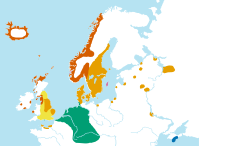
Back Roes (volk) Afrikaans شعب الروس Arabic Rus (xalq) Azerbaijani Рус Bulgarian Rus (poble) Catalan Rus (národ) Czech Rws Welsh Rus (folk) Danish Rus (Volk) German Ρως Greek


The Rus',[a] also known as Russes,[2][3] were a people in early medieval Eastern Europe.[4] The scholarly consensus holds that they were originally Norsemen, mainly originating from present-day Sweden, who settled and ruled along the river-routes between the Baltic and the Black Seas from around the 8th to 11th centuries AD. In the 9th century, they formed the state of Kievan Rusʹ, where the ruling Norsemen along with local Finnic tribes gradually assimilated into the East Slavic population, with Old East Slavic becoming the common spoken language. Old Norse remained familiar to the elite until their complete assimilation by the second half of the 11th century,[5] and in rural areas, vestiges of Norse culture persisted as late as the 14th and early 15th centuries, particularly in the north.[5]
The history of the Rus' is central to 9th through 10th-century state formation, and thus national origins, in Eastern Europe. They ultimately gave their name to Russia and Belarus, and they are relevant to the national histories of Russia, Ukraine and Belarus. Because of this importance, there is a set of alternative so-called "Anti-Normanist" views that are largely confined to a minor group of Eastern European scholars.
- ^ Rosenwein, Barbara H. (14 February 2014). A Short History of the Middle Ages, Volume I: From c.300 to c.1150, Fourth Edition. University of Toronto Press. p. 121. ISBN 978-1-4426-0616-6.
- ^ Dolukhanov, Pavel (10 July 2014). The Early Slavs: Eastern Europe from the Initial Settlement to the Kievan Rus. Routledge. p. 182. ISBN 978-1-317-89222-9.
- ^ Magill, Frank N. (12 November 2012). The Middle Ages: Dictionary of World Biography, Volume 2. Routledge. p. 803. ISBN 978-1-136-59313-0.
- ^ Duczko (2004).
- ^ a b Melnikova, E.A. (2003) The Cultural Assimilation of the Varangians in Eastern Europe from the Point of View of Language and Literacy in Runica – Germ. – Mediavalia (heiz./n.) Rga-e 37, pp. 454–465 Archived 15 February 2022 at the Wayback Machine.
Cite error: There are <ref group=lower-alpha> tags or {{efn}} templates on this page, but the references will not show without a {{reflist|group=lower-alpha}} template or {{notelist}} template (see the help page).
© MMXXIII Rich X Search. We shall prevail. All rights reserved. Rich X Search